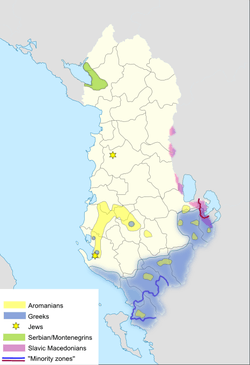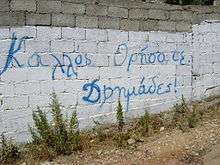Languages of Albania
| Part of a series on the |
| Culture of Albania |
|---|
 |
|
Traditions |
|
Mythology and folklore |
|
Festivals |
|
Music and performing arts |
|
Monuments |
|
|
| Languages of Albania | |
|---|---|
| Official languages | Albanian |
| Minority languages | Greek, Macedonian, Romani, Serbian, Aromanian |
| Main foreign languages | Italian, Greek, English |
| Sign languages | Albanian Sign Language |


Albania is an ethnically homogeneous country, where the overwhelming majority of the population speaks Albanian, which is also the official language. It has two distinct dialects: Tosk, spoken in the south, and Gheg, spoken in the north. However many Albanians speak Italian, Greek, French, German, English and Serbian, amongst other languages too, due to the high numbers of Albanian diaspora.
Albania is one of the most polyglot nations in Europe.[1] Italian is widely spoken throughout Albania. Greek, the language of the Greek minority of the south, is also very widespread in that region. Nowadays, knowledge of English is growing very rapidly, especially among the youth. Various languages are spoken by ethnic minorities: Greek, Macedonian, etc.
Status of Albanian
The Article 14 of the Albanian Constitution states that "The official language in the Republic of Albania is Albanian."[2] According to the 2011 population census, 2,765,610 or 98.767% of the population declared Albanian as their mother tongue ("mother tongue is defined as the first or main language spoken at home during childhood").[3]
Dialects
Standard Albanian is based on Tosk dialect, spoken in the south. Gheg is spoken in the north and also by Kosovo Albanians. The traditional border between the two dialects in Shkumbin River. Although they are different, they are mutually intelligible.[4][4][5]
Minority languages

Greek
Greek is the largest minority language of Albania and first largest foreign language. Because the number of Greeks in Albania is disputed, the exact number of native speakers of Greek is unknown. The Greeks of Albania speak a modern southern Greek dialect, known as Northern Epirote Greek.[6] Alongside Albanian loanwords, it retains some archaic forms and words that are no longer used in Standard Modern Greek, as well as in the Greek dialects of southern Epirus. Despite the relatively small distances between the various towns and villages, there exists some dialectal variation,[7] most noticeably in accent.[8] In addition, many Albanians have knowledge of Greek, mainly due to past immigration to Greece.
Aromanian

Aromanian is the native language for about 100,000 to 200,000 Aromanians of Albania.[9][10] They mostly live in the southern and central regions of the country. The Aromanians, under the name "Vlachs", are a recognized cultural minority in the Albanian law.[11]
Macedonian
According to the 1989 census, there were approximately 5,000 Macedonian language-speakers in Albania. Most of these people live in the southeastern part of the country in the Lake Prespa region.[12] Macedonians are an officially recognized minority in the Pustec Municipality. However, only the Macedonians living in Pustec are allowed to declare their nationality and language. Ethnic Macedonian organization claim that 120.000 to 350,000 Macedonians live in Albania.[13] They are politically represented by the Alliance of Macedonians for European Integration, which in the 2011 elections received ~2,500 votes.[14]
Romani
About 10,000 Romani people live in Albania today. They have preserved the language, despite the lack of education in that language.[15]
Serbo-Croatian
Serbo-Croatian is mostly spoken and understood in northern Albania, near the border of former Yugoslavian countries of Serbia and Montenegro.[1] The television phenomenon of Italian also happened to Serbo-Croatian, but to a lesser extent.[16]
Foreign languages
Italian
Italian is by far the best-known foreign language in Albania and used to have official status when the country was a protectorate of Italy.[1] Most Italian-speakers have not learnt the language in classrooms or from books, but rather by watching Italian television.[16] During the late communist regime, Albanians living in the towns along the Adriatic Sea coast had access to Italian television.[17] Many Albanians "grew skilled at rewiring their TVs to overcome [the] Albanian government's attempt to block Italian channels".[18] A large number of middle-aged and younger people grew up with the language and know it very well.[1]
Among the elderly, Italian is also common as the language was used in the educational system in the 1930s, after King Zog released a decree requiring all Albanian schools to teach Italian in 1933.[19]
English
English is mostly popular among the younger generations of Albanians.[20][21] Since the 1990s it is the most-taught foreign language in the Albanian educational system. As of 2006, more than 65% of Albanian children could speak fluent or semi-fluent English.[22]
The language came to Albania in 1921, when the Albanian Vocational School started to teach English with the sponsorship of the American Red Cross. The school operated until 1933.[19] The Albanian Government at the time decided to make English the country's second language.[23] Russian became the major language taught in schools after the Communists took control over the country. After the Soviet-Albanian Split in the 1960s, English came to compete with Russian.[19] A 2006 book by Mimoza Rista-Dema, a Ph.D. in Linguistics at Indiana University, describes the teaching of English during the communist era:
| “ | Although English was taught at schools, it was considered the language of Western imperialism and as a result, elements of its culture and civilization were offered to English learners selectively.[24] | ” |
Other
French lycées in Korçë and Gjirokastër operated during the communist era, because long-time leader of Communist Albania, Enver Hoxha studied in the University of Montpellier in France and upon his rise to power allowed their activity. Albania is a member of la Francophonie. Most French-speakers in Albania can be found in these two towns and surrounding areas, but also elsewhere in the country.[1]
Russian began to be taught in schools and universities in the 1950s, when it was lingua franca of the Eastern Bloc countries, part of which was Albania.[19] It continued until the Soviet–Albanian split in early 1961. Many who learnt in at the time, have forgotten most of it due to lack of usage.[1]
After the ideological controversies with the USSR, Albania and China came closer. A number of Albanians studied in China and learnt Chinese there. After the collapse of communism in Albania in 1991, many young Albanians also traveled to China for education and learned the language.[1]
References
- 1 2 3 4 5 6 7 Gloyer, Gillian (2008). Albania: the Bradt travel guide (3rd ed.). Chalfont St. Peter: Bradt Travel Guides. p. 44. ISBN 9781841622460.
- ↑ "Constitution of the Republic of Albania" (PDF). Republic of Albania Council of Ministers. Retrieved 12 November 2012.
- ↑ http://census.al/Resources/Data/Census2011/Instat_print%20.pdf
- 1 2 Baker, Colin; Jones, Sylvia Prys (1998). Encyclopedia of bilingualism and bilingual education. Clevedon: Multilingual Matters. p. 412. ISBN 9781853593628.
- ↑ Dana, Leo Paul (2001). Economies of the Eastern Mediterranean region : economic miracles in the making. Singapore [u.a.]: World Scientific. p. 47. ISBN 9789810244743.
- ↑ Appendix A. History & Diatopy of Greek. The story of pu: The grammaticalisation in space and time of a Modern Greek complementiser. December 1998. University of Melbourne.Nick Nicholas.
- ↑ Encyclopedia of the stateless nations: ethnic and national groups around the world. James Minahan. Greenwood Publishing Group, 2002. ISBN 0-313-32384-4.
- ↑ Contested Spaces and Negotiated Identities in Dhermi/Drimades of Himare/Himara area, Southern Albania. Nataša Gregorič Bon. Nova Gorica 2008.
- ↑ According to INTEREG - quoted by Eurominority: Aromanians in Albania, Albania's Aromanians; Reemerging into History
- ↑ Arno Tanner. The forgotten minorities of Eastern Europe: the history and today of selected ethnic groups in five countries. East-West Books, 2004 ISBN 978-952-91-6808-8, p. 218: "In Albania, Vlachs are estimated to number as many as 200,000"
- ↑ Schwandner-Sievers, Stephanie. "The Albanian Aromanians´ Awakening: Identity Politics and Conflicts in Post-Communist Albania" (PDF). European Centre for Minority Issues. Retrieved 13 November 2012.
- ↑ "LOCAL SELF-GOVERNMENT AND DECENTRALIZATION: CASE OF ALBANIA. HISTORY, REFORMES AND CHALLENGES" (PDF). Retrieved 16 November 2012.
- ↑ United Nations High Commissioner for Refugees. "World Directory of Minorities and Indigenous Peoples - Albania : Macedonians". Unhcr.org. Retrieved 2013-07-26.
- ↑ "Results of the 2011 local elections of Albania" (PDF). Central Elections Commission of Albania. 2011. Retrieved 14 December 2012.
- ↑ Hemming, Andreas (2010). Albania: family, society and culture in the 20th century. Münster: LIT. p. 132. ISBN 9783643501448.
- 1 2 Hemming, Andreas (2010). Albania: family, society and culture in the 20th century. Münster: LIT. p. 183. ISBN 9783643501448.
- ↑ Pardo-de-Santayana, Manuel; Pieroni, Andrea; Puri, Rajindra K. (2010). Ethnobotany in the new Europe : people, health, and wild plant resources (1. publ. ed.). New York: Berghahn Books. p. 29. ISBN 9781845454562.
- ↑ McAdam, Marika; Jayne d' Arcy; Chris Deliso; Peter Dragicevic (2009). Western Balkans (2nd ed.). Footscray, Vic.: Lonely Planet. p. 96. ISBN 9781741047295.
- 1 2 3 4 Rista-Dema 2006, p. 14.
- ↑ Vorhees, Mara (2009). Eastern Europe. (10th ed.). Footscray, Vic.: Lonely Planet. p. 43. ISBN 9781741048544.
- ↑ IBP USA Staff, International Business Publications, USA (2008). Albania Company Laws and Regulations Handbook. Int'l Business Publications. p. 228. ISBN 9781433069338.
- ↑ Rista-Dema 2006, p. 16.
- ↑ Rista-Dema 2006, p. 12.
- ↑ Rista-Dema 2006, p. 15.
- Rista-Dema, Mimoza (2006). Inverse-order constructions in Albanian English discourse and prototype effects. [Bloomington, Ind.]: Indiana University. ISBN 9780542847905.
| Wikimedia Commons has media related to Languages of Albania. |
